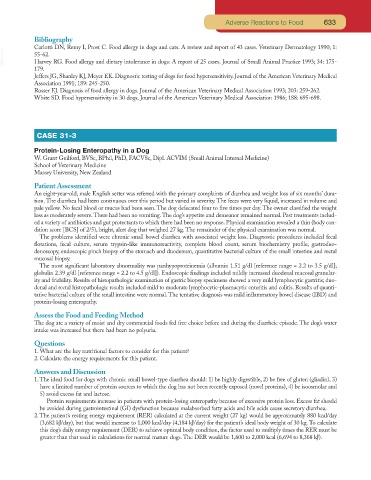Page 611 - Small Animal Clinical Nutrition 5th Edition
P. 611
Adverse Reactions to Food 633
Bibliography
Carlotti DN, Remy I, Prost C. Food allergy in dogs and cats. A review and report of 43 cases. Veterinary Dermatology 1990; 1:
VetBooks.ir 55-62.
Harvey RG. Food allergy and dietary intolerance in dogs: A report of 25 cases. Journal of Small Animal Practice 1993; 34: 175-
179.
Jeffers JG, Shanley KJ, Meyer EK. Diagnostic testing of dogs for food hypersensitivity. Journal of the American Veterinary Medical
Association 1991; 189: 245-250.
Rosser EJ. Diagnosis of food allergy in dogs. Journal of the American Veterinary Medical Association 1993; 203: 259-262.
White SD. Food hypersensitivity in 30 dogs. Journal of the American Veterinary Medical Association 1986; 188: 695-698.
CASE 31-3
Protein-Losing Enteropathy in a Dog
W. Grant Guilford, BVSc, BPhil, PhD, FACVSc, Dipl. ACVIM (Small Animal Internal Medicine)
School of Veterinary Medicine
Massey University, New Zealand
Patient Assessment
An eight-year-old, male English setter was referred with the primary complaints of diarrhea and weight loss of six months’ dura-
tion. The diarrhea had been continuous over this period but varied in severity. The feces were very liquid, increased in volume and
pale yellow. No fecal blood or mucus had been seen. The dog defecated four to five times per day. The owner classified the weight
loss as moderately severe.There had been no vomiting.The dog’s appetite and demeanor remained normal. Past treatments includ-
ed a variety of antibiotics and gut protectants to which there had been no response. Physical examination revealed a thin (body con-
dition score [BCS] of 2/5), bright, alert dog that weighed 27 kg. The remainder of the physical examination was normal.
The problems identified were chronic small bowel diarrhea with associated weight loss. Diagnostic procedures included fecal
flotations, fecal culture, serum trypsin-like immunoreactivity, complete blood count, serum biochemistry profile, gastroduo-
denoscopy, endoscopic pinch biopsy of the stomach and duodenum, quantitative bacterial culture of the small intestine and rectal
mucosal biopsy.
The most significant laboratory abnormality was panhypoproteinemia (albumin 1.51 g/dl [reference range = 2.2 to 3.5 g/dl];
globulin 2.39 g/dl [reference range = 2.2 to 4.5 g/dl]). Endoscopic findings included mildly increased duodenal mucosal granular-
ity and friability. Results of histopathologic examination of gastric biopsy specimens showed a very mild lymphocytic gastritis; duo-
denal and rectal histopathologic results included mild to moderate lymphocytic-plasmacytic enteritis and colitis. Results of quanti-
tative bacterial culture of the small intestine were normal.The tentative diagnosis was mild inflammatory bowel disease (IBD) and
protein-losing enteropathy.
Assess the Food and Feeding Method
The dog ate a variety of moist and dry commercial foods fed free choice before and during the diarrheic episode. The dog’s water
intake was increased but there had been no polyuria.
Questions
1. What are the key nutritional factors to consider for this patient?
2. Calculate the energy requirements for this patient.
Answers and Discussion
1. The ideal food for dogs with chronic small bowel-type diarrhea should: 1) be highly digestible, 2) be free of gluten (gliadin), 3)
have a limited number of protein sources to which the dog has not been recently exposed (novel proteins), 4) be isoosmolar and
5) avoid excess fat and lactose.
Protein requirements increase in patients with protein-losing enteropathy because of excessive protein loss. Excess fat should
be avoided during gastrointestinal (GI) dysfunction because malabsorbed fatty acids and bile acids cause secretory diarrhea.
2. The patient’s resting energy requirement (RER) calculated at the current weight (27 kg) would be approximately 880 kcal/day
(3,682 kJ/day), but that would increase to 1,000 kcal/day (4,184 kJ/day) for the patient’s ideal body weight of 30 kg. To calculate
this dog’s daily energy requirement (DER) to achieve optimal body condition, the factor used to multiply times the RER must be
greater than that used in calculations for normal mature dogs. The DER would be 1,600 to 2,000 kcal (6,694 to 8,368 kJ).

